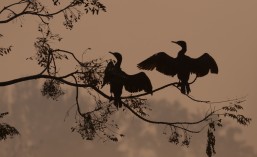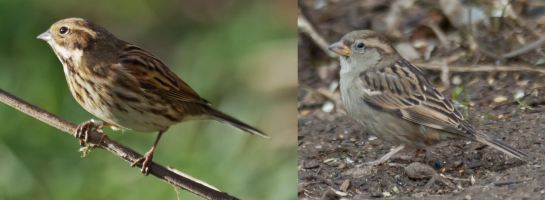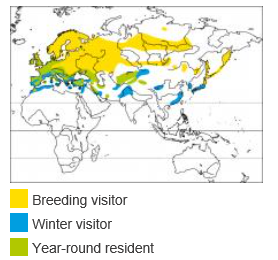Order: Passeriformes Family: Emberizidae Conservation Status: Least Concern
Synonyms: Reed Bunting, Reed Sparrow, Fen Sparrow, Northern Reed Bunting, Dark Reed Bunting, Pale Reed Bunting
Description:
The Common Reed Bunting is a sparrow-sized bird measuring 15 to 16 cm in length with a wingspan of 21 to 25 cm and weighing 15 to 21 grams. There is significant sexual dimorphism in this species, especially during the breeding season.
Male:
When in breeding plumage, the adult male has a black head and throat, white hind-neck collar, thin white moustache and grey-brown upperparts which are heavily blackish streaked. The scapular feathers are blackish with a rufous edge. The tail is deeply notched and is blackish brown with extensive white on the edges, which is prominent in flight. The underparts are whitish and the breast sides and flanks have variable streaking. The bill is small and dark grey, whilst the eyes are dark reddish-brown and the legs and feet are pink-brown.
In non-breeding plumage, the head becomes dull brown, the white collar disappears and the sub-moustachial stripe and throat turn whitish whilst the chin becomes more buff coloured. With the exception of the wings and tail, the upperparts become slightly paler. The lower mandible of the bill turns bluer at this time.
Female:
In breeding plumage, the female Common Reed Bunting is similar in appearance to the non-breeding male with a paler nape and prominent malar stripe. The breast and flanks are streaked dark. Additionally there are buff lines both above and below the eye and the bill appears more blackish.
The non-breeding female is similar to the non-breeding male in appearance with minor differences on crown pattern markings.
Female Common Reed Buntings, and non-breeding males, are similar in size and appearance to the House Sparrow (Passer domesticus) but are distinguishable by their streaked underparts and white outer tail feathers. The tail, which is notched, is also longer than that of the House Sparrow.
The juvenile Common Reed Bunting is similar in appearance to the female but has a more chestnut crown with heavy dark streaking, a broader malar stripe and yellowish upperparts marked with spots and streaks. The flanks and belly are spotted whilst the breast is also heavily streaked. The eyes of the juvenile are dark grey-brown.
Call and Vocalisation:
During breeding season, the song of the male Common Reed Bunting is described as a monotonous, repetitive “zrip”, or a staccato chirrup “tweek, tweek, tititweek”. Other calls include a shrill “tseeu”. In flight a deep “chewp” can be heard.
Common Reed Bunting Call
Common Reed Bunting Male Song
Common Reed Bunting Alarm Call
Range and Distribution:
The Common Reed Bunting can be found across much of Europe and temperate and northern Asia. Birds from the northern parts of the range migrate and winter southwards. Other subspecies in warmer climates are resident breeders.
There are currently nineteen recognized subspecies which can be categorized into four major groups:
Northern Group:
ssp. schoeniclus: Breeds in Europe from Scandinavia, eastwards to the Pechora Basin and Urals, south to the British Isles, through most of France, Western Austria, Northern Italy, and across South-West Russia. Some migratory movement – northerly birds winter in North Africa and South-West Asia
ssp. passerina: Breeds in north-west Siberia, winters in South Asia, east to Northern India and Western China
ssp. parvirostris: Breeds in Central Siberia and winters in North-West and northern China
ssp. lusitanica: Sedentary in Portugal and North-West Spain
Eastern Group:
ssp. pyrrhulina: Breeds in Eastern Siberia and Northern Japan, winters in Central Japan, Korea and Eastern China
Intermediate Group:
ssp. stresemanni: Sedentary in Eastern Austria, Hungary and Northern Serbia
ssp. ukrainae: Sedentary in Ukraine and adjacent South-West Russia
ssp. incognita: Sedentary in South-East European Russia, eastwards to Northern Kazakhstan
ssp. pallidior: Breeds in South-West Siberia, eastwards to Lake Baikal. Winters in South-West and South-Central Asia
Southern Group:
ssp. witherbyi: Sedentary on the French Mediterranean coast, Sardinia, Balearic Islands, Spain (except north-west) and North-West Morocco.
ssp. intermedia: Sedentary in Italy and along the Adriatic coast, south to North-West Albania
ssp. tschusii: Sedentary along the River Danube in Bulgaria and Romania, and in the northern Black Sea region and the coastline of the Sea of Azov.
ssp. reiseri: Sedentary is South-East Albania, North-West Greece, Southern Macedonia and Western and Central Turkey.
ssp. caspia: Sedentary in Eastern Turkey, eastwards to Eastern Transcaucasia, Northern Iran and possibly also in Syria.
ssp.korejewi: Sedentary in South-West and South-East Iran and Southern Turkmenistan
ssp. pyrrhuloides: Breeds in the northern Caspian Sea region, eastwards to Western Mongolia, South-East Kazakhstan and Central Tien-Shan. Winters in South-West and Central Asia
ssp. harterti: Sedentary in extreme southern Russia, extreme eastern Kazakhstan and extreme North-West China in Xinjiang province.
ssp. centralasiae: Sedentary in the Tarim Basin, eastwards to Xinjiang
ssp. zaidamensis: Sedentary in the Zaidam Depression, in North-West Qinghai, Western China
Habitat:
The Common Reed Bunting is typically found in wetlands, often in wet vegetation on waterlogged soil such as reed beds, rushes, willow thickets and estuarine marshes. However, due to habitat loss from wetland drainage, the Common Reed Bunting has been forced to adapt and can now just as readily be seen in farmlands and gardens, especially in overgrown hedgerows and ditches.
Diet:
The Common Reed Bunting feeds on seeds in low vegetation close to, or on, the ground. During the breeding season they will additionally feed on insects, spiders, snails and small crustaceans.
Breeding:
The breeding season for the Common Reed Bunting typically starts in April or May and runs to mid-July.
In mid-March males can often be seen on exposed perches, singing to claim territory. Once this is established the male will then further use his song, accompanied by vibrating his wings and flicking his tail, to attract females. The female will build a nest close to the ground in bushes or reed tussocks in a wet or marshy place. The cup-shaped nest is built from grass, reed stems and moss and is lined with fine grasses and hair. A clutch of 4 to 7 smooth glossy pale lilac or olive eggs, marked with blotches or black scrawls, is typically laid. 2 to 3 clutches may be laid in any one season. The eggs are incubated for 12 to 14 days by the female. After hatching both parents care for, and feed, the chicks for a further 10 to 13 days before they fledge.
During the nesting the parents will defend the nest from predators by feigning injury, dragging a wing behind them to lure the predator away from the nest.
Behaviour:
Common Reed Buntings often can be seen foraging with other similar species such as larks, pipits and finches. During the breeding season foraging is typically alone or in pairs as territories are tightly defended. Outside of the breeding season small, loose flocks may form. These flocks may aggregate at night time to form communal roosts, usually in extensive reed banks close to water.
When flushed Common Reed Buntings will rise rapidly high into the air before diving down to take cover in vegetation.
Conservation Status:
Globally the Common Reed Bunting is classified as least concern. It is common or locally common across its range and populations across Europe appear to be stable.
However, in the UK the Common Reed Bunting is categorised as an Amber species, meaning it is highly vulnerable, and is protected under the Wildlife and Countryside Act 1981. Populations of this species in the UK have historically suffered from low hatching success and a high degree of fledgling mortality, falling by 50% between 1970 and 1980. It is thought that changes to agricultural practices, such as increased use of pesticides and a general loss of farm diversity due to crop specialisation contributed to this effect. Additionally, poor land management of wetland habitats, such as land drainage and river engineering further contributed.
Now the Common Reed Bunting is included in English Nature’s Species Recovery Programme. This programme aims to create new reed beds and restore existing ones back to habitable conditions.


